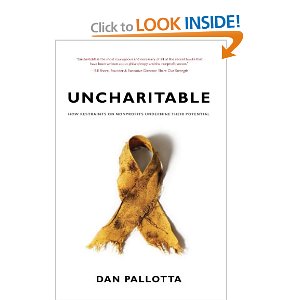![]() Non-profit professionals all seem to be saying the same thing to me about technology and social media . . . “We’re tired. It is confusing. It evolves too quickly. We still haven’t figured out what works. We don’t have the time or money to invest in conferences, trainings, staff and resource manuals to figure all of this out.”
Non-profit professionals all seem to be saying the same thing to me about technology and social media . . . “We’re tired. It is confusing. It evolves too quickly. We still haven’t figured out what works. We don’t have the time or money to invest in conferences, trainings, staff and resource manuals to figure all of this out.”
Yep! This is the plight of the modern, small, under-resourced non-profit organization. For some executive directors, fundraising professionals and program/ops staff, this becomes frustrating and even hopeless.
My best advice to everyone is to fight this feeling and fight it with every fiber of your being. The future is upon us, and the way non-profit agencies communicate with the outside world is changing rapidly. The consequences associated with falling too far behind the social media and technology curve can mean the difference between staying in business and becoming obsolete.
You’re reaction is probably something like . . . WHAT?!?!
 I get that, but I really don’t think I am being a drama queen here. In the future (and I do mean the not-so-distant future), social media and technology will be how your non-profit does a lot of communicating with:
I get that, but I really don’t think I am being a drama queen here. In the future (and I do mean the not-so-distant future), social media and technology will be how your non-profit does a lot of communicating with:
- clients
- board members
- volunteers
- staff
- donors
- prospective donors and the community-at-large
Don’t believe me?
Well, just the other day I was walking down the street while in Vancouver on vacation when I saw a homeless man sitting outside of a restaurant on the sidewalk. While it is impossible to know if he was homeless, he was at least someone who was obviously “down on his luck“. He was young and couldn’t have been older than 25-years-old. He was frantically pecking away on a smartphone and obviously stealing a WiFi signal from the restaurant. I couldn’t help but wonder if he was searching webpages or social media sites to see which soup kitchens, food pantries or shelters were open that day.
The future is upon us, friends! To give in now to those hopeless feelings you have about social media and technology would be a mistake. The solution is to push forward and embrace change.
I know, I know. There are no resources. It always comes down to this for non-profit organizations. Doesn’t it?
Well, this is where Michael Stelzner enters the picture!
What? You haven’t discovered Mike yet? In a nutshell, he is the CEO of Social Media Examiner. Here is an excerpt from his website describing his company:
“The world’s largest online social media magazine, Social Media Examiner helps businesses discover how to best use social media, blogs and podcasts to connect with customers, drive traffic, generate more brand awareness and increase sales. Our mission is to help you navigate the constantly changing social media jungle.“
Click here or on the YouTube video below for a fun little introduction:
[youtube=http://www.youtube.com/watch?feature=player_embedded&v=54c5M2IrX0I]
He regularly publishes blogs and podcasts about a variety of social media topics. Here are just a few of his recent works:
- Pinterest Success: Creative Ways to Use Pinterest for Your Business
- 2013 Social Media Marketing Industry Report
- Email and Social Media: Why Marketers Need Both
Here is the bottom line. Dedicating yourself to the idea of becoming a “lifelong learner” will be the saving grace for your non-profit organization. People like Michael Stelzner are your salvation. He puts out good stuff, and it is FREE. All you need to do now is:
- click-through and subscribe to his online magazine and podcasts,
- prepare for the regular stream of emails containing his material, and
- find time to read and listen to his stuff.
Oh right . . . time is a resource and something many of my non-profit friends tell me that don’t have enough of. OK, I suggest that you download Michael’s podcasts to your smartphone and listen to him on the treadmill in the morning or while driving between your daily meetings.
Nothing in life is as simple as clicking on a button. You will need to work at this and find the time to become a lifelong learner, but the viability of your non-profit organization is depending on you.
Please go check-out Michael Stelzner and his amazing online magazine. Click around his site. Listen to a few podcast. Circle back around to this blog post and share your thoughts in the comment box below. We can all learn from each other.
Here’s to your health!
Erik Anderson
Founder & President, The Healthy Non-Profit LLC
www.thehealthynonprofit.com
erik@thehealthynonprofit.com
http://twitter.com/#!/eanderson847
http://www.facebook.com/eanderson847
http://www.linkedin.com/in/erikanderson847











 Identifying blog topics can be hard. Sometimes you find a comfort zone and ideas flow freely. Other times, it is next to impossible and the writers block is crippling. So, I love it when readers sometimes email me on the side and suggest topics.
Identifying blog topics can be hard. Sometimes you find a comfort zone and ideas flow freely. Other times, it is next to impossible and the writers block is crippling. So, I love it when readers sometimes email me on the side and suggest topics.






